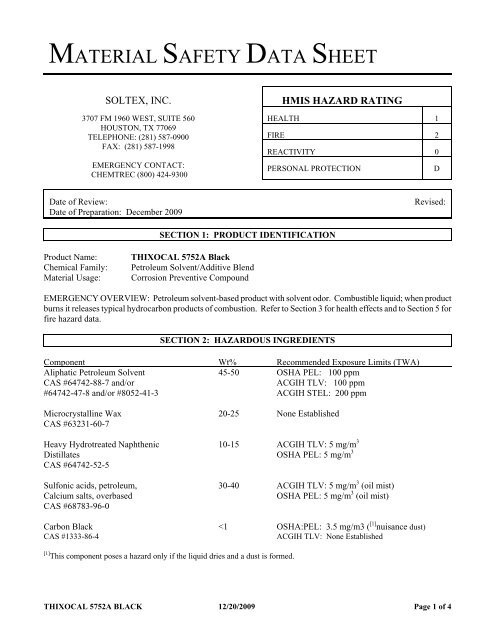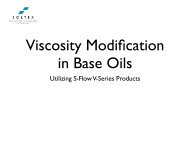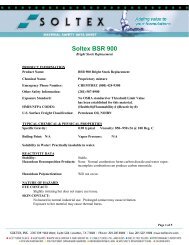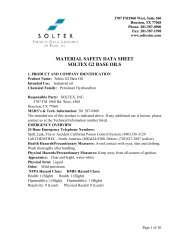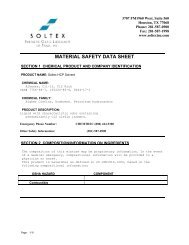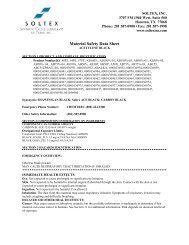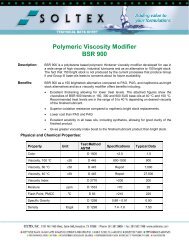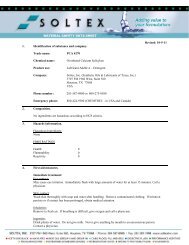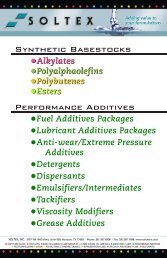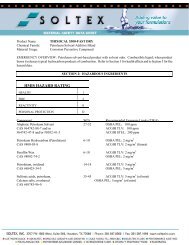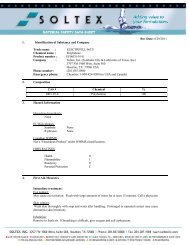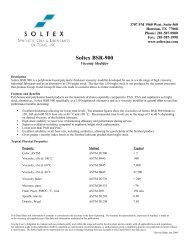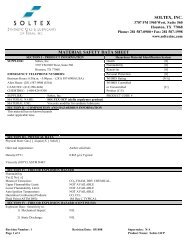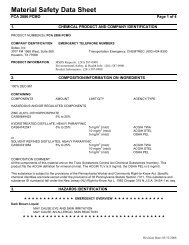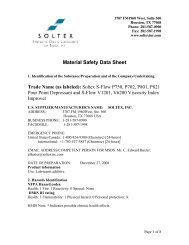You also want an ePaper? Increase the reach of your titles
YUMPU automatically turns print PDFs into web optimized ePapers that Google loves.
<strong>MATERIAL</strong> <strong>SAFETY</strong> <strong>DATA</strong> <strong>SHEET</strong><br />
SOLTEX, INC.<br />
3707 FM 1960 WEST, SUITE 560<br />
HOUSTON, TX 77069<br />
TELEPHONE: (281) 587-0900<br />
FAX: (281) 587-1998<br />
EMERGENCY CONTACT:<br />
CHEMTREC (800) 424-9300<br />
HMIS HAZARD RATING<br />
HEALTH 1<br />
FIRE 2<br />
REACTIVITY 0<br />
PERSONAL PROTECTION<br />
D<br />
Date of Review:<br />
Date of Preparation: December 2009<br />
Revised:<br />
SECTION 1: PRODUCT IDENTIFICATION<br />
Product Name:<br />
Chemical Family:<br />
Material Usage:<br />
THIXOCAL 5752A Black<br />
Petroleum Solvent/Additive Blend<br />
Corrosion Preventive Compound<br />
EMERGENCY OVERVIEW: Petroleum solvent-based product with solvent odor. Combustible liquid; when product<br />
burns it releases typical hydrocarbon products of combustion. Refer to Section 3 for health effects and to Section 5 for<br />
fire hazard data.<br />
SECTION 2: HAZARDOUS INGREDIENTS<br />
Component Wt% Recommended Exposure Limits (TWA)<br />
Aliphatic Petroleum Solvent 45-50 OSHA PEL: 100 ppm<br />
CAS #64742-88-7 and/or<br />
ACGIH TLV: 100 ppm<br />
#64742-47-8 and/or #8052-41-3 ACGIH STEL: 200 ppm<br />
Microcrystalline Wax 20-25 None Established<br />
CAS #63231-60-7<br />
Heavy Hydrotreated Naphthenic 10-15 ACGIH TLV: 5 mg/m 3<br />
Distillates OSHA PEL: 5 mg/m 3<br />
CAS #64742-52-5<br />
Sulfonic acids, petroleum, 30-40 ACGIH TLV: 5 mg/m 3 (oil mist)<br />
Calcium salts, overbased<br />
OSHA PEL: 5 mg/m 3 (oil mist)<br />
CAS #68783-96-0<br />
Carbon Black
SECTION 3: HEALTH HAZARD INFORMATION<br />
Primary Routes of Entry: Inhalation, skin absorption.<br />
Acute Effects: Excessive inhalation may produce dizziness, nausea, headache, and incoordination. May cause<br />
severe eye irritation and reversible skin irritation. Prolonged skin exposure may cause dermatitis or oil acne.<br />
Breathing mists may cause dizziness or pulmonary irritation.<br />
Chronic Overexposure:<br />
Carcinogenicity: None of the components of this product are listed as carcinogens by NTP, IARC, or OSHA<br />
1910(Z).<br />
Pre-Existing Medical Conditions Aggravated by Exposure: Exposure may aggravate pre-existing respiratory or<br />
skin problems.<br />
SECTION 4: FIRST AID PROCEDURES<br />
Inhalation: Move victim to fresh air and call emergency medical care. If not breathing, give artificial respiration; if<br />
breathing is difficult, give oxygen.<br />
Eyes: In case of contact with material, immediately flush eyes with running water for at least 15 minutes. Seek<br />
immediate medical attention.<br />
Skin: Wash skin with soap and water. Remove and isolate contaminated clothing and shoes at the site.<br />
Ingestion: DO NOT INDUCE VOMITING. Consult a physician. If vomiting occurs spontaneously, keep head<br />
below hips to prevent aspiration of liquid into the lungs.<br />
Flash Point: 105 ο F. (TCC )<br />
Explosive Limits: LEL: 0.6 UEL: 7.0<br />
SECTION 5: FIRE AND EXPLOSION HAZARD <strong>DATA</strong><br />
EXTINGUISHING MEDIA: Small Fires: Dry chemical, CO 2 , water spray, or regular foam. Large Fires: Water<br />
spray, fog, or regular foam. Move container from fire area if you can do it without risk. Apply cooling water to sides<br />
of containers that are exposed to flames until well after fire is out. Stay away from ends of tanks. For massive fire in<br />
cargo area, use unmanned hose holder or monitor nozzles. If this is impossible, withdraw from area and let fire burn.<br />
Withdraw immediately in case of rising sound from venting safety device or any discoloration of tank due to fire.<br />
Special Firefighting Protection/Emergency Action: Fire may produce irritating or poisonous gases. Positive<br />
pressure self-contained breathing apparatus (SCBA) and structural firefighters' protective clothing will provide limited<br />
protection. Keep unnecessary people away; isolate hazard area and deny entry. Stay upwind; keep out of low areas.<br />
Isolate for 1/2 mile in all directions if tank, rail car or tank truck is involved in fire. If runoff from fire control occurs,<br />
notify the appropriate authorities.<br />
Unusual Fire/Explosion Hazards: Flammable/combustible material; may be ignited by heat, sparks or flames.<br />
Vapors may travel to a source of ignition and flash back. Container may explode in heat of fire. Vapor explosion<br />
hazard indoors, outdoors or in sewers. Runoff to sewer may create fire or explosion hazard.<br />
Products of Combustion: Carbon monoxide, carbon dioxide, oxides of sulfur, miscellaneous hydrocarbons.<br />
SECTION 6: SPECIAL PRECAUTIONS AND SPILL/LEAK PROCEDURES<br />
Steps to be taken in case Material is Released or Spilled: Shut off ignition sources; no flares, smoking or flames in<br />
hazard area. Stop leak if you can do it without risk.<br />
Small Spills: Take up with sand or other noncombustible absorbent material and place into containers for later<br />
disposal.<br />
Large Spills: Dike far ahead of liquid spill for later disposal.<br />
THIXOCAL 5752A BLACK 12/20/2009 Page 2 of 4
SECTION 7: SAFE HANDLING INFORMATION<br />
Precautions To Be Taken In Handling/Storage: Store in cool, well-ventilated area. Keep away from flames, sparks<br />
or hot surfaces. Never use a torch to cut or weld on or near container. Empty containers can contain explosive vapors.<br />
Other Precautions: Never wear contaminated clothing. Launder or dry clean before wearing. Discard oil-soaked<br />
shoes. Wash thoroughly with soap and water (waterless hand cleaner may be helpful in removing residues) after use<br />
and before smoking or eating. Avoid excessive skin contact.<br />
SECTION 8: EXPOSURE CONTROLS<br />
Respiratory Protection: NIOSH-approved respirator for organic vapor and mist to control exposure where<br />
ventilation is inadequate.<br />
Ventilation: General and local exhaust.<br />
Personal Protective Equipment: Protective Gloves: Impervious gloves (Viton, PVOH, etc.) Eye Protection: Safety<br />
glasses with sideshields or chemical goggles. Other Protective Clothing or Equipment: If splashing is anticipated,<br />
wear rubber apron and boots or other protective equipment to minimize contact.<br />
SECTION 9: REACTIVITY HAZARD <strong>DATA</strong><br />
Stability: Stable<br />
Incompatibility: Strong acids, oxidizing agents.<br />
Hazardous Decomposition Products: Carbon monoxide, carbon dioxide, oxides of sulfur, miscellaneous<br />
hydrocarbons.<br />
Hazardous Polymerization: Will not occur.<br />
SECTION 10: PHYSICAL AND CHEMICAL PROPERTIES<br />
Color:<br />
Black<br />
Appearance:<br />
Viscous Liquid<br />
Odor:<br />
Petroleum Solvent<br />
Boiling Point (initial): >300 ο F.<br />
Evaporation Rate (n-Butyl Acetate=1): 1<br />
Solubility in Water:<br />
Not Determined<br />
Specific Gravity: .99<br />
pH:<br />
Not Applicable<br />
Percent Volatile by Volume: 36<br />
SECTION 11: DISPOSAL CONSIDERATIONS<br />
Waste Disposal Methods: Dispose of in accordance with state, local and federal regulations. Materials may<br />
become a hazardous waste through use. If permitted, incineration may be practiced. Consider recycling solvent.<br />
SECTION 12: REGULATORY INFORMATION<br />
Volatile Organic Content: (Calculated Values)<br />
VOC per gallon:<br />
VOC per gallon minus exempt solvents and water:<br />
EPA Hazardous Waste Number(s) (40CFR Part 261):<br />
EPA Hazard Category (40CFR Part 370):<br />
2.5 lbs/gal<br />
2.5 lbs/gal<br />
D001<br />
DELAYED (CHRONIC)<br />
FIRE (COMBUSTIBLE)<br />
THIXOCAL 5752A BLACK 12/20/2009 Page 3 of 4
SARA TITLE III<br />
This product contains the following TOXIC CHEMICALS subject to the Reporting Requirements of Sec. 313 of<br />
Title III of the Superfund Amendments and Reauthorization Act of 1986, and of 40CFR Part 372:<br />
CHEMICAL CAS NO. WT %<br />
NONE<br />
This product contains the following EXTREMELY HAZARDOUS SUBSTANCE(S) subject to the Emergency<br />
Planning Requirements under Sec. 301-303 (40CFR Parts 300 and 355) and Emergency Release Notification<br />
Requirements under Sec. 304:<br />
CHEMICAL CAS NO. WT % RQ/TPQ Lbs<br />
NONE<br />
(CERCLA LIST) This product contains the following HAZARDOUS SUBSTANCE(S) subject to Emergency<br />
Release Notification Requirements under Sec. 304 (40 CFR Part 302):<br />
CHEMICAL CAS NO. WT % Final RQ Lbs<br />
Aliphatic Petroleum Solvent 64742-88-7 45-50 100<br />
and/or 64742-47-8<br />
and/or 8052-41-3<br />
CALIFORNIA PROPOSITION 65<br />
This product may contain trace quantities of the following chemicals that are identified by the State of California<br />
under the Safe Drinking Water and Toxic Reinforcement Act of 1986 ("Proposition 65") as either a carcinogenic<br />
or reproductive hazard:<br />
CHEMICAL CAS NO. Estimated Concentration %<br />
Carbon Black 1333-86-4


